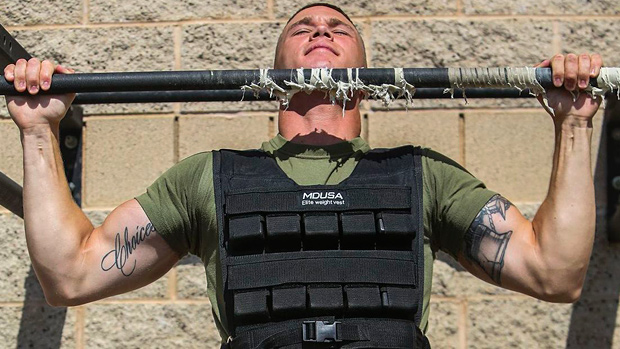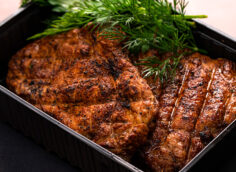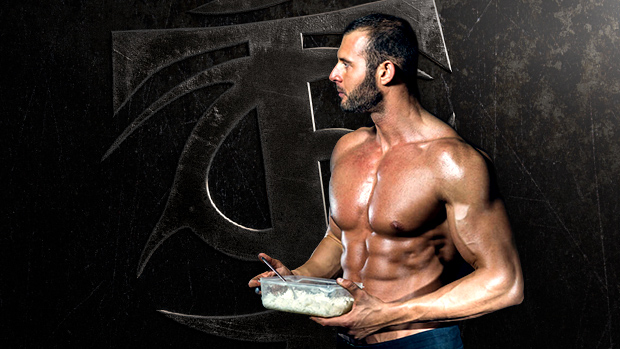Low-fat-this, low-carb that... dietary dogma swings both ways like a metro-sexual at an after hours party. It can really get overwhelming. (I know. Here, have a hanky.) In a world of tunnel vision, first dominated by fat fears and now by a killer-carb craze, this series of articles will write the world a healthy reality check. It pays-out in common sense, so come on over to Lonnie's latest smart-bank location, set up right here in downtown T-Nation.
In the Part 1 and Part 2 of this series, we examined ways for "dieters" to keep calories low while keeping portion sizes up. Now we're going to examine the other side of the "energy balance equation": kcal output.
But before we get too deep, here's a figure to illustrate what I'll be writing about:

Figure 1. The Energy Balance "Scale"
You can see clearly how there are two major ways we can reach a mild (perhaps 30% below maintenance) negative energy balance: reduce intake as in this series' earlier articles, or "drain" calories in subtle ways via extra physical activity (and even a few other metabolic tricks).
In order to get smaller, hopefully through the waist, we need to tip the scale toward loss (energy out) as opposed to storage (surplus energy in). Of course, the best approach is to use both restriction and expenditure because too little eating hurts nutrient intake and too much activity risks overtraining–especially for those who are susceptible via their dieting efforts.
Fortunately, physical activity (aside from an hour under the weights) doesn't only mean regular intense exercise or daily boring treadmill work. Those of you familiar with my writing know that I'm also a fan of keeping tabs on non-exercise physical activity, or "NEPA".
For certain individuals in a fat loss stalemate, this may be the very "unexplained factor" that's limiting progress. NEPA can really fall-off as a diet progresses and leptin/ T3/ metabolism falls – without you even noticing it! Think about it: Do you actually measure how much you move outside of the gym, six weeks into a "diet"? If you don't, your body could be compensating for its negative energy balance by reducing overall daily movement and "vigor" (getting out of the house, walking, standing, fidgeting, hobbies, chores, staying awake, spontaneous activity, even sex). One must maintain or control his NEPA or risk contaminating his calorie-reduction efforts with compensatory laziness at home.
Believe it or not, I even carry this non-exercise approach over to my "cardio". My battleground is not the treadmill or bike. I want to save my biological resources for moving the iron, not waste them on cardio.
Cardio. I've never liked that word. Who says aerobic activity has to be intense enough to be cardiovascularly challenging? For the physique-specific athlete (i.e. bodybuilder), aerobic exercise can be mild enough to get one VERY lean without taxing the cardio-pulmonary and nervous systems (which induce a catabolic stress hormone response, among other problems). A noted exercise physiologist I recently met actually insists that any chatting done in his office is done with everyone casually pedaling on stationary bikes rather than sitting in chairs!
My concern with frequent or intense cardiovascular exercise is that, however trendy with bodybuilders, it can reduce muscular gains. I see this as particularly troublesome for beginners and intermediates trying to spare newly acquired muscle mass as they lean-out.
So what can we do? What could be included in a traditional ripping phase for maximal results? There are a number of things.
- Pedometer readings in a workout log: By recording daily movement, we can monitor how fatigued we're getting from a ripping phase. Remember that we spend about 90% of the day outside of the gym. If you typically accumulate 8,000 steps per day and a month into a "diet" you've dropped to 5,000 there may be a problem.
- Additional "dead weight" during the day: It's like living on the surface of a massive planet with huge gravity! When used with (mostly) fasted morning walks and daily chores, a loaded backpack, wrist and ankle and waist weights, or more orthopedically correct, a 40 pound X-vest * can help "burn" kcal quite a bit faster. How much faster? Here's a self-applied experiment for you: Try inputting your usual body weight for a half hour on a treadmill. Then try entering a body weight 40 pounds heavier for that same duration! Plus, this "dead weight approach" provides muscle-preserving resistance rather than just a steeper or faster treadmill. No, X-vests aren't specifically made for this calorie drain concept but the trick works!
- >Strictly scheduled chores: Get out a calendar or schedule book and write them down. This helps make the NEPA schedule "official". Mow your lawn every Saturday morning at 10:00 and walk your untrained dog every Monday, Wednesday, and Friday immediately after gym sessions. (I had a little discussion with T-Nation forum veteran, Tampa Terry, on this a while back; the dog thing can indeed look embarrassing but it's a great idea!). Pick just two or three mildly physically demanding chores or you may lose track relative to your NEPA goals.
- Scheduled, habitual personal "sports" or lifestyle activities: Martial arts activities of your liking (tai chi, Tae Kwon Do hyung/ poomse, Kendo suburi exercises, etc.) are great if kept in-check metabolically. So are yoga/ stretching, soccer ball juggling, skateboarding, some surfing, a game of "pig"... whatever. Just don't let them get too intense if NEPA and muscle preservation–rather than performance–is your current goal. Here's a tip: keep activity equipment in plain sight (I have stuff by my front door right in the living room).
- Although great in so many ways, team sports should be limited to one-two times weekly if muscle preservation during "dieting" is the real goal. They're typically too intense for low-mid-intensity NEPA purposes. Again, we need to reserve biological reserves (glycogen, nervous system, etc.) for the gym.
* I received an X-vest for evaluation purposes and can say that:
- It takes a fully-loaded 40-pound vest to really rack-up additional calories during a typical treadmill session; less weight seems to do little from a calorie wasting point of view.
- I could really feel that extra weight initially, even in my feet.
- Some chores are a little awkward, especially when trying to sit briefly between them while wearing the vest and
- I admit that I felt a little silly at first, walking around the neighborhood in what looks like a bulletproof vest but hey, I could do it every single morning because it was less demanding than running.
You get the concept. Pick something you enjoy that calls for movement but not hard exertion and make it habitual. Record it in your training log; NEPA may be that one overlooked variable that's sabotaging your fat loss efforts. If you don't have a favorite sporting activity or chore to do regularly, go for morning walks before a carb-containing breakfast or do evening walks after dinner. Walking (including weighted walking via an X-vest, ankle and wrist weights, etc.) is a hugely underrated activity and provides not only calorie draining, but "active recovery" for a hard-training bodybuilder. It's not meant to be "conditioning" or be any additional stimulus for that matter. A competitive powerlifter friend of mine, "Fortress," has even done this to help his neuromuscular recovery while keeping off excess fat gain during bulking phases. It works.
Next time we'll get a little freaky with some metabolic tricks beyond the mild, non-gym physical activities discussed here. They're not for everyone but are interesting concepts to ponder when one is nearing the end of a metabolism-crushing diet!





